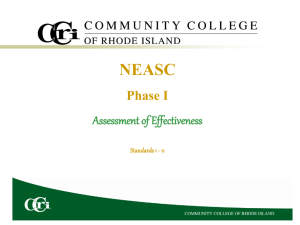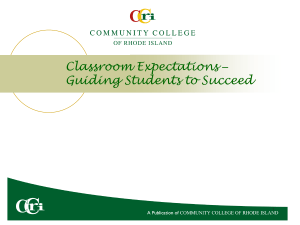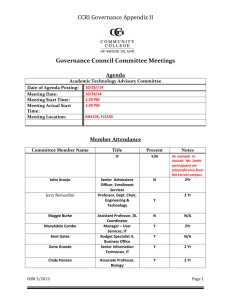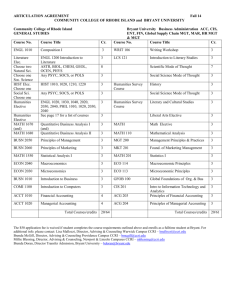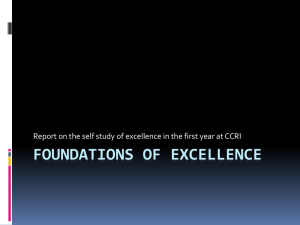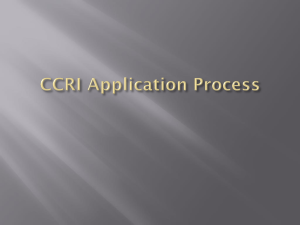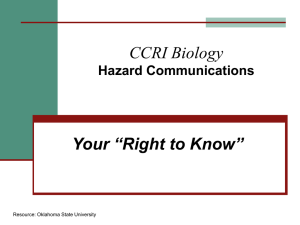Description - Community College of Rhode Island
advertisement
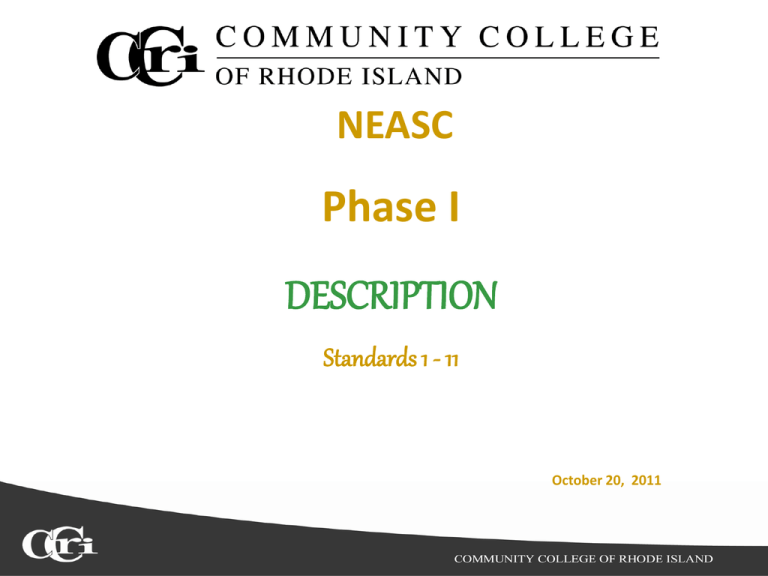
NEASC Phase I DESCRIPTION Standards 1 - 11 October 20, 2011 Goals of today’s meeting: Share preliminary Description of each Standard Provide feedback from Committee-of-theWhole ~ Did we miss big areas we might want to include? Share feedback from the NEASC Conference on October 13- 14 Provide direction for completing the preliminary Appraisal of each Standard Standard One: Mission & Purpose #1 Adopted August 21, 2006 by BOG In print: Viewbook, Strategic Plan, Student Resource Guide, Catalog Primary website: www.ccri.edu/about/mission/html Standard One: Mission & Purpose #2 Questions / Issues to consider Is our current mission statement as prominent as it should be? Do students, faculty, staff know at least elements of the mission? Does the current wording reflect the 21st C. Commission Report recommendations/new wording of our charter by the legislature? Is the April 2005 draft version statement reflected in the current mission and/or should it be reviewed? Standard One: Mission & Purpose #3 Next Steps Consider places where the mission should be. Consider possible survey to see who knows the mission (or at least parts of it) – students, faculty, staff, general public. Improve visibility of mission ( in strategic locations). Standard Two: Planning & Evaluation #1 President’s Council primary planning body BOG Goals & Priorities: “ Performance Indicators” BOG requires annual Management Letter (Since 1982) Capital Improvement Plan (BOG 2013-17); CCRI Campus Master Plan (RFP; “renewal/expansions”) Strengthening IR&P; Utilizing data-IRPL web Mission, Strategic Planning Process & “Plan” (2009-2012 Strategies driven by Strategic Plan Examples: Business Affairs metrics, IR tracking cohorts metrics, learning outcomes metrics in some departments Standard Two: Planning & Evaluation #1 Standard Two: Planning & Evaluation #3 Foundations of Excellence self study 21st Century Workforce Commission Report Academic Program Review (5 year cycle for APR) Student Learning Outcomes Faculty Development & CITLA Faculty Evaluation Process (built, approved, implemented) Institutional Planning Council (part of “governance model”) APR & Learning Outcomes Assessment developing measurement strategies Wabash Study of Liberal Arts Education Standard Three: Organization & Governance #1 Locations Four Campuses o o o o Lincoln Newport Providence Warwick Other Locations Down City Providence Westerly Learning Modalities o o o o Classroom Online Television Hybrid Standard Three: Organization & Governance #2 CCRI Functional Organizational Chart BOARD OF GOVERNORS DIRECTOR OF MARKETING, COMM. & PUBLICATIONS Richard H. Coren EXEC. DIRECTOR PROVIDENCE CAMPUS Walter Crocker (Interim) PRESIDENT Ray Di Pasquale AFFIRMATIVE ACTION John White (Interim) AVP for ENROLLMENT MANAGEMENT (Vacant) DEAN INSTITUTIONAL ADVANCEMENT (Vacant) AVP for STUDENT SERVICES Ronald L. Schertz VICE PRESIDENT ACADEMIC AFFAIRS Lela M. Morgan VICE PRESIDENT BUSINESS AFFAIRS Robert J. Shea Jr. · Arts, Humanities, & Social Sciences · Accounting · Enrollment Services · Access /Disability Serv. · Alumni · Bookstore · Admissions · Advising & Counseling · Foundation Business, Science & Technology · Bursar’s Office · Financial Aid · Athletics · Grants Health & Rehabilitative Sciences · Business Office · Cooperative Education · Controller’s Office · EOC/ETS · Human Resources · Health Services · Info Technology · Reach Program · Payroll · · Physical Plant · Purchasing Student Life/Service Learning/Student Government · Security · Student Success · · · Library DIRECTOR INST. PLANNING & RESEARCH William LeBlanc AVP WORKFORCE & COMMUNITY EDUC. Robin Smith · Adult Ed./Literacy Services · Community Educ./ Personal Develop. · Training & Develop. · Institute for Leadership & Organizational Development Updated 08/10/2011 Standard Three: Organization & Governance #3 CCRI Functional Governance Chart Standard Four: The Academic Program #1 Department o o o o o o o o o o Syllabi Policies unique to individual programs Printed materials used for distribution Program Assessment Templates Academic Program Reviews Advisory Council Minutes Performance Data Minutes o o o o o o o o Academic Advisory Curriculum Committee General Education Learning Outcomes Assessment Distance Learning President’s Council ASAC ATAC Standard Four: The Academic Program #2 Data Analysis Divide the individual criteria (54) between the 9 committee members Distribute all data collected to each committee member Request the committee to comment on what is being done at this point in time relative to their assigned criteria Identify “good practices” and “areas of concern” Standard Four: The Academic Program #3 Projected Timeframes Data collection to be completed by Thanksgiving Report of performance according to the criteria will be completed by December 12 Standard Five: Faculty #1 Full-time vs. Adjunct ratio has remained static (≈40% vs. 60%) for the past 8 years Population slightly less diverse Detailed handbooks are now available for both categories Faculty evaluation processes now consistent among all departments Standard Five: Faculty #2 Most programs have undergone APR process Faculty development opportunities have increased (CITLA, IT workshops, etc) Standard Five: Faculty #3 No consistent policy found to ensure role of adjuncts in fulfilling mission of college No contracts for adjuncts (handbook does address many resources available) Faculty pay not consistent with peer institutions Standard Six: Students #1 Admissions The primary mission of Community College of Rhode Island is to offer recent high school graduates and returning adults the opportunity to acquire the knowledge and skills necessary for intellectual, professional and personal growth through an array of academic, career and lifelong learning programs. CCRI has an open admissions policy that gives all Rhode Island residents an opportunity for education beyond the high school level; there are no specific enrollment target goals. The college has a diverse student population, reflective of the diversity represented in the state. All admission and retention policies comply with state and federal statues regarding equal opportunity and are available to the public via the college web site as well as in the annual college catalog. All accepted students are given placement examinations in basic skills, a full complement of remedial courses is available for those who require remediation. Students with other special needs can be served and assisted through Disability Services for Students should they elect to request them. Other specialized admission requirements are in place for specialized programs such as health sciences. Standard Six: Students #2 Retention & Graduation The College supports all students in achieving their academic goals by the provision of both specialized and general programs that support academic success. General programs available to all students include tutoring and study skills support, co-operative education, academic advising and career counseling. Specialized programs include Disability Services for Students; REACH, a state-funded program for students on public assistance; and TRiOfunded student support services programs and educational opportunity centers. The College maintains and publicizes retention and graduation rates through the Office of Institutional Research in print and on-line. Statistics are available in aggregate and in many commonly used sub-categories. This data is frequently used in long term and strategic planning projects. Standard Six: Students #3 Student Services The College utilizes historical data and student demand to determine the learning needs of individual students. Academic supports, advising, and other student supports are available on all four campuses of CCRI, though at varying degrees of availability. Student Services at CCRI encompass Advising and Counseling, Athletics, Career Services, Cooperative Education and Internships, Opportunity and Outreach, Student Life, and Student Success Centers. These services are available to all enrolled, degree-seeking students. Information on these services is available online, in college publications, the student resource guide, and reviewed in person during Freshman Registration sessions and New Student Orientations. Nearly $39,000,000.00 in financial aid was disbursed to nearly 50% of all enrolled students in the fall of 2010. Support for students seeking financial aid is provided by the Office of Enrollment Services and the Educational Opportunity Center. Students have the opportunity to develop leadership skills through a collection of student clubs and organizations, a small student government program, and a robust service learning program. Athletic programs are run in compliance with or exceed all NJCAA standards. Student rights and obligations are laid out in a Code of Conduct that is regularly reviewed. Federally required information on safety and privacy of information is presented online and in various publications. The College has begun a regular and systematic review of student satisfaction annually. Standard Seven: Library & Other Information Resources #1 7.1 - Mission 7.2 - Planning & Budget Both library & IT describe resources and services that support the CCRI mission. Institution maintains increased level of funding for both. IT is addressed in 3 Strategic Plan goals; IT Governance supports department planning. 7.3 – Appropriate Modes Modes: Classroom and online DL-2008/71 in 2011/131 CSM – 2008/202 in 2011/352 Library: Increased # of electronic resources Standard Seven: Library & Other Information Resources #2 7.4 - Staffing IT has 41 FTE (filled positions). Library has 21 FTE (filled positions). 7.5 - Access IT Help Desk (40 hrs. per week); Academic Computer Lab (71.5 weekly) Library (60 hrs. per week) Assistive technologies available 7.6 – Training & Support Library: Reference services, inst. Classes, library guides, online…. Inst. Tech: CIT, consultations, workshops, tech. days, mentors… Info. Tech: Orientation, Banner training, e-learning, workshops…. Standard Seven: Library & Other Information Resources #3 7.9 – Demonstrates Use & Proficiency Appropriate to Degree Technology MYCCRI, LMS, Website, Email, Courses Students offered technology training Information Resources Library databases, print / online material Library courses and instruction 7.10 – Increasingly Sophisticated Skills in Evaluating Information Library 6875 attended library research sessions Library offers 2 credit bearing research courses 7.11 – Institutional Effectiveness NEASC accreditation process - Strategic Plan - Advisory Committees Standard Eight: Physical & Technological Resources #1 Addressing Deferred Maintenance Preparing for Future Facility Needs Ameresco – Self-Funded Asset Protection -Warwick and Lincoln Field Houses Re-Roofed, Megastructure Project Starting RICAP - 2/3 of HVAC Units replaced at Flanagan Campus and 2/3 of Building Reroofed. Master Plan RFP Access, Safety, Security and Healthful Environment Stimulus Funding - New Fire Alarm and Sprinkler Systems in Warwick, Lincoln, and Providence. Standard Eight: Physical & Technological Resources #2 Appropriately Equipped Facilities Five-Year Replacement Plan for Classroom Furniture Renovation of Dental Hygiene Lab Infrastructure Bandwidth Upgrade to 10Gbps Adoption of Blackboard 9.1 including the introduction of lecture capture, streaming video and smart interactive whiteboards Ninety-five percent of classrooms technology-enhanced with many having single panel control of all audio-visual equipment Technology upgrades in the Liston Campus Auditorium Knight TV Studio offering new media opportunities Multiple laptop carts for lab use in the Sciences. Ongoing desktop replacement cycle with newest operating systems and most recent office suite Standard Eight: Physical & Technological Resources #3 Resource Planning Linked to Academic and Student Services, Support Functions and Financial Planning Renovation of Warwick Auditorium Implementation of the Operational Data Store and Argos for enhancing enterprise-wide reporting and delivery of data on demand Enhanced Student Services - Wait Listing, Financial Aid Processing, Electronic Add/Drop Functionality, Direct Deposit of Student Payroll, Bookstore Purchasing, E-Refund of Financial Aid Checks and E-Billing. Space Planning R25/X25 Standard Eight: Physical & Technological Resources #4 Study and Research – Physical and Electronic Environments Renovation of Warwick Library Collaborative Technology Suites Centers for Instructional Technology Monitors and Respond to Illegal or Inappropriate Uses of Technology Systems and Resources Network access control for authentication and remediation of wired and wireless devices ensuring infrastructure security and filtering of potentially infected connections Payment card industry compliance for all credit card handling applications and payment gateways Standard Eight: Physical & Technological Resources #5 Reliability, Integrity and Security of Data, Privacy Knight Campus Data Center re-design for cooling and power management Flanagan Campus Data Center construction for disaster recovery and business continuity planning Desktop virtualization through Cisco UCS Blade Technology and VMware for secure, sustainable, reliable and consistent user technology experience High availability, Fault Tolerant Enterprise Level Backup System Secondary Internet Connections at Knight and Newport with Liston and Flanagan in Planning Conversion of all Internet-Facing Web Pages to Comprehensive Content Management System with Alternative Off-Campus Page Storage Site for Disaster Planning Standard Nine: Financial Resources #1 Strength continues to lie in a centralized budget/resource management process staffed by fiscal professionals, resulting in clean externally validated audits. Improvements have been made to ensure that up-to-date fiscal information is accessible on college web site. Strong enrollment with affordable tuition have offset the reduction of state support. Standard Nine: Financial Resources #2 College is leveraging alternate funding opportunities such as grants, capital campaign, energy performance program and financial aid for students. Instruction, academic support & student service activities account for the majority of college expenditures. Standard Nine: Financial Resources #3 Interim report suggested “strengthening the engagement of faculty & staff in use of data decision making process” – a cultural shift that creates inter-divisional friction. Strategic planning, goals & objectives have not come full circle with resource planning yet – still divisional silo’s. Standard Ten: Public Disclosure #1 Role of Marketing & Communications Client Service Model Proactive as well as Reactive Changes to Disclosure - more gradual and thus less unsettling Real – time updates to electronic resources Scheduled updates to printed resources Standard Ten: Public Disclosure #2 Pending Responses to NEASC Initiatives Acceptance of CCRI’s Fifth Year Interim Report (3/25/09) NEASC Policy Statement on Student Achievement & Success (4/07) Standard Eleven: Integrity #1 2004 NEASC Self-Study Projection 8 Appraisal Items 3 Continuing Concerns Adjunct Faculty Code of Ethics Fairness in Hiring Standard Eleven: Integrity #2 Overall Concern Some Federal / State / BOG / CCRI Policy Guidance for all elements of Standard 11 Defacto CCRI policies, procedures, and practices No official CCRI policy manual Standard Eleven: Integrity #3 2009 NEASC Interim Report 3 Appraisal items 2 Continuing concerns including 2004 report Governance Effectiveness Fairness in Hiring Review of Self-Evaluation Form (adapted from WASC) Using historical information since last ten-year visit: What are 2-3 most important issues for us to address? What is our overall effectiveness in each area? What are our major strengths and areas for improvement? What evidence do we have to back our statements?
